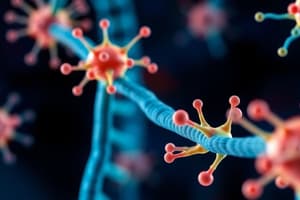Podcast
Questions and Answers
What is the primary function of nuclear receptors?
What is the primary function of nuclear receptors?
- Regulating transcription by binding to DNA (correct)
- Transporting hormones in the bloodstream
- Degrading mRNA molecules
- Acting as enzymes to modify DNA
Which of the following is NOT a form in which nuclear receptors can bind to response elements?
Which of the following is NOT a form in which nuclear receptors can bind to response elements?
- Heterodimers
- Tetramers (correct)
- Homodimers
- Monomers
Where are steroid hormone receptors located in the absence of a ligand?
Where are steroid hormone receptors located in the absence of a ligand?
- In the cell membrane
- In the cytosol (correct)
- In the mitochondria
- In the nucleus
What occurs upon ligand binding to a steroid hormone receptor?
What occurs upon ligand binding to a steroid hormone receptor?
How do steroid receptors typically bind to DNA?
How do steroid receptors typically bind to DNA?
What defines a hormone response element (HRE)?
What defines a hormone response element (HRE)?
What are the three defining features of a response element?
What are the three defining features of a response element?
What happens to the ligand-receptor complex after it translocates into the nucleus?
What happens to the ligand-receptor complex after it translocates into the nucleus?
What is the role of the heat-shock protein (HSP) in relation to steroid hormone receptors?
What is the role of the heat-shock protein (HSP) in relation to steroid hormone receptors?
Flashcards are hidden until you start studying
Study Notes
Nuclear Receptors Overview
- Nuclear receptors function as regulatory transcription factors.
- They bind to regulatory DNA sequences known as response elements.
Binding Forms of Nuclear Receptors
- Can bind as:
- Monomers: Example, steroidogenic factor-1 receptor.
- Homodimers: Example, steroid receptors.
- Heterodimers: Examples, retinoic acid receptor, thyroid hormone receptor, vitamin D receptor, and several orphan nuclear receptors.
Steroid Hormone Receptors
- Located in the cytosol in an inactive form stabilized by heat-shock proteins (HSP).
- Ligand binding causes dissociation of HSPs, allowing translocation to the nucleus.
Mechanism of Action in the Nucleus
- The ligand-receptor complex binds to specific hormone-response elements (HRE) in DNA after nuclear translocation.
- Steroid receptors bind as homodimers to inverted repeats with a three-nucleotide spacer sequence.
Characteristics of Hormone Response Elements (HRE)
- HREs are specific DNA sequences recognized by receptors with high affinity.
- Typically consist of two consensus hexameric half-sites.
- Three critical features define a response element:
- Sequence of base pairs in each half-site.
- Number of base pairs separating the half-sites.
- Relative orientation of the half-sites.
Importance of Response Element Recognition
- Each dimeric receptor must accurately identify the sequence, spacing, and orientation of the half-sites within the response element to effectively bind DNA.
Studying That Suits You
Use AI to generate personalized quizzes and flashcards to suit your learning preferences.




